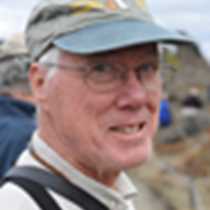Northeastern Spitsbergen
During the night, National Geographic Explorer passed along the north coast of Spitsbergen to reach the island's northeast corner, where we entered Sorgfjorden. We were here to visit a haulout of walrus, where male walrus leave the water to gather in a large heap of some 30 or so (they can be hard to count in such a pile) huge blubbery bodies, flippers, and ivory tusks (actually, about 60 of them.) Male walrus take no part in the raising of their young. They have little to do between breeding seasons but to eat, survive, grow (the better to compete for females next season), and molt their brown fur. They appear awkward and slothful on land, but in the water walrus are active, agile and graceful. They are among the most social of animals, spending much of their time, both on land and in the water, in the close company of others of their kind.
The source of the name Sorgfjorden (Fjord of Sorrow) was soon revealed. A large wooden cross stands on a hilltop above our landing spot, and nearby we found thirty piles of stones in a neat and orderly array. Each pile covers the final resting place of a late 17th Century whaler. In 1693 three French men-of-war, protecting the interest of French whalers, came upon and attacked a fleet of forty Dutch whaling ships. The graves are the consequence. A huge amount of effort went into gathering and piling large stones over the wooden coffins to deter marauding polar bears, as the whalers would treat the remains of their fellows as they would want their own to be treated.
We rounded the corner of Spitsbergen and turned south down Hinlopen Strait, a narrow channel that separates Spitsbergen from Nordaustlandet, the island to the east. Here, at Cape Fanshawe, we visited a colony about 100,000 pairs of thick-billed murres and kittiwakes. During most of the year these are true seabirds, with no need at all to visit the land, but now, for a few short months, they come to the cliffs to breed. Unlike the walrus, the male and females birds share in the chores of parenthood. The attending parents are packed onto narrow ledges, shoulder to shoulder, black side out, holding their single egg against the cliff while the mate is away feeding, and then the two switch places. The air was full of their comings and goings. It is an astonishing sight.
From the sociality of walrus and seabirds, our next experience was one of solitude. We entered a small bay where the Hinlopen glacier reaches the sea. Far away, standing on the shore-fast ice in front of the glacier face, was a tiny yellowish object seen against the white of the glacier, and it moved. We had encountered the object of our search, the polar bear. Our ship entered the ice and slowly advanced, pushing aside and occasionally breaking the floes. Gradually the tiny spot transformed into the figure of a bear. This bear showed no desire to interact with us. It walked away at almost precisely the pace at which our ship approached, thus keeping its distance. We will search for another bear for the look that we all so crave.



